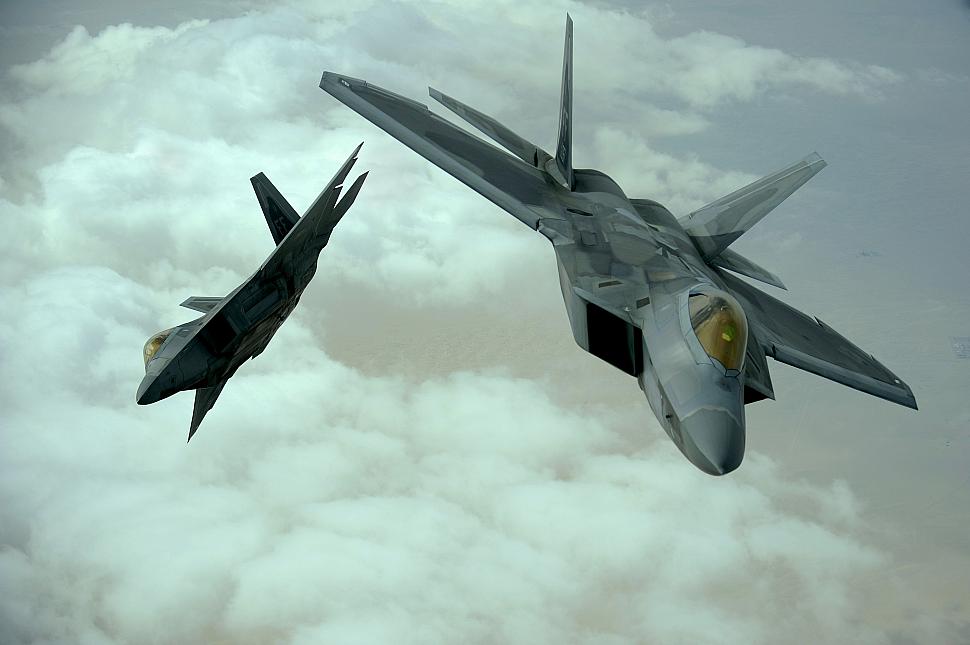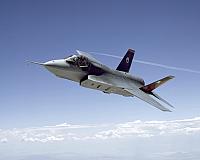Fighter Jet News
F-22 Raptor News
Aircraft with advantages, or the next generation of wasted money?
January 10, 2010 (by
Kent Harris) -
The Air Force is spending hundreds of billions of dollars on two fighter jets that probably will never be used to support troops on the ground in Iraq or Afghanistan.

Congress has decided to cap production of the F-22, removing funding for the fifth-generation fighter from the 2010 military budget. And the F-35 — also known as the Joint Strike Fighter — won’t be ready for prime time before 2013, according to the latest estimates.
Critics of the new fighters say they are too expensive and not needed in today's warfare, while proponents argue that the current aircraft are not as advanced as the F-22 and F-35, both of which would help the U.S. maintain air superiority for decades to come.
The programs have come under heavy criticism, mainly for cost overruns.
Each F-22 — there are about 140 of them assigned to six stateside bases — will have cost about $350 million under current estimates. The U.S. is awaiting delivery of roughly 50 more of them.
Winslow Wheeler, director of the Straus Military Reform Project of the Center for Defense Information and a vocal critic of both programs, predicts each F-35 might eventually cost almost $200 million.
Guy Ben-Ari, a fellow at the Center for Strategic and International Studies, said the costs are "raising eyebrows left and right. At the end of the day, it comes down to resources, and they’re not endless."
Despite those concerns, the fighters’ advantages cannot be ignored, some officials say.
Maj. John Peterson, requirements officer for the F-35A at Air Force headquarters, said each fifth-generation fighter has four features that make it superior to fourth-generation models such as the F-16, F-15 and F/A-18. Some fourth-generation models might have some of the capabilities, but none has all four, he said.
Those four are the ability to evade enemy radar; maneuverability; the ability to take on varied tasks; and the ability to translate more data into usable information for the pilot.
A look at each aircraft:
F-22 Raptor
Christopher Preble, writing on the blog he maintains for the Cato Institute, said he believes the F-22 "likely never will" participate in actions over Iraq or Afghanistan. But Preble, director of foreign policy studies for the institute, said that doesn’t necessarily make it a bad aircraft.
"I have no reason to question the F-22's capability," he said in a recent telephone interview.
Ben-Ari, a member of CSIS’ Defense-Industrial Initiatives Group, agreed with that assessment.
He said the F-22 might be able to carry out missions to support ground troops, but said that other aircraft such as the F-16 and A-10 are better designed to do so. The F-22 is thought to be better suited for taking on enemy aircraft and anti-aircraft positions as opposed to enemy forces engaged with friendly troops on the ground.
But there is the cost factor.
Preble cited a Washington Post article that stated that the cost of flying an F-22 is about $40,000 per hour.
So using the F-22 for a mission that other aircraft could handle, Ben-Ari said, "would be in the same manner as a Lamborghini used to bring your kids to school. You could do it, but do you really need to?"
Maj. Clay Bartels, F-22 requirements officer for Air Force headquarters at the Pentagon, said he believes the F-22 could take on ground-support missions today if called upon. But he said its primary role — ensuring U.S. superiority in the skies — isn’t needed in today’s wars.
"Air superiority is achieved already," he said in a phone interview.
Supporters say the F-22 is so technologically superior to other fighters that it will use advanced detecting and targeting systems to take out enemy planes from miles away. In such cases, enemy planes might not have even known they were in a fight until it was too late.
F-35A Joint Strike Fighter
The Air Force expects to receive the first of its 1,763 aircraft in 2013 — if testing goes according to plan.
The Marine Corps recently took possession of the first versions of the F-35 from Lockheed Martin and has begun its own testing. Congress overrode Pentagon misgivings and decided to spend an additional $465 million on an alternative engine for the F-35.
The Air Force, which projects that the F-35 will make up half its fleet in 2025, is involved in a system development and demonstration phase that Peterson said is set to last until 2014.
Wheeler, who once worked for the General Accounting Office, said that means the service will have purchased a significant number of aircraft that haven’t been fully tested. And he said he believes too much of the current testing is in the form of simulated models and table-top theories. He said more tests must involve actually flying the F-35.
Peterson and Bartels said the F-35 and F-22 are designed to provide specific, complementary roles for the service. But they’re only part of the picture. The service projects that some of the current generation of fighters will be used for decades to come.
Ben-Ari said the Air Force needs to not only deal with conflicts today, but also plan for future ones. "For the missions we’re conducting today, the current fleet is capable," he said. "For future ones … I’m not so sure.
"You can’t just draw up a design for a new aircraft and produce it in six months," he said. "You’re hedging against future risk. No politician or military officer wants to be the one who, looking back through history, canceled a project or ignored a risk."
USAF F-22A Raptors break formation during a training mission on December 6th, 2009, over Southwest Asia.
Critics of the new fighters say they are too expensive and not needed in today's warfare, while proponents argue that the current aircraft are not as advanced as the F-22 and F-35, both of which would help the U.S. maintain air superiority for decades to come.
The programs have come under heavy criticism, mainly for cost overruns.
Each F-22 — there are about 140 of them assigned to six stateside bases — will have cost about $350 million under current estimates. The U.S. is awaiting delivery of roughly 50 more of them.
Winslow Wheeler, director of the Straus Military Reform Project of the Center for Defense Information and a vocal critic of both programs, predicts each F-35 might eventually cost almost $200 million.
Guy Ben-Ari, a fellow at the Center for Strategic and International Studies, said the costs are "raising eyebrows left and right. At the end of the day, it comes down to resources, and they’re not endless."
Despite those concerns, the fighters’ advantages cannot be ignored, some officials say.
Maj. John Peterson, requirements officer for the F-35A at Air Force headquarters, said each fifth-generation fighter has four features that make it superior to fourth-generation models such as the F-16, F-15 and F/A-18. Some fourth-generation models might have some of the capabilities, but none has all four, he said.
Those four are the ability to evade enemy radar; maneuverability; the ability to take on varied tasks; and the ability to translate more data into usable information for the pilot.
A look at each aircraft:
F-22 Raptor
Christopher Preble, writing on the blog he maintains for the Cato Institute, said he believes the F-22 "likely never will" participate in actions over Iraq or Afghanistan. But Preble, director of foreign policy studies for the institute, said that doesn’t necessarily make it a bad aircraft.
"I have no reason to question the F-22's capability," he said in a recent telephone interview.
Ben-Ari, a member of CSIS’ Defense-Industrial Initiatives Group, agreed with that assessment.
He said the F-22 might be able to carry out missions to support ground troops, but said that other aircraft such as the F-16 and A-10 are better designed to do so. The F-22 is thought to be better suited for taking on enemy aircraft and anti-aircraft positions as opposed to enemy forces engaged with friendly troops on the ground.
But there is the cost factor.
Preble cited a Washington Post article that stated that the cost of flying an F-22 is about $40,000 per hour.
So using the F-22 for a mission that other aircraft could handle, Ben-Ari said, "would be in the same manner as a Lamborghini used to bring your kids to school. You could do it, but do you really need to?"
Maj. Clay Bartels, F-22 requirements officer for Air Force headquarters at the Pentagon, said he believes the F-22 could take on ground-support missions today if called upon. But he said its primary role — ensuring U.S. superiority in the skies — isn’t needed in today’s wars.
"Air superiority is achieved already," he said in a phone interview.
Supporters say the F-22 is so technologically superior to other fighters that it will use advanced detecting and targeting systems to take out enemy planes from miles away. In such cases, enemy planes might not have even known they were in a fight until it was too late.
F-35A Joint Strike Fighter
The Air Force expects to receive the first of its 1,763 aircraft in 2013 — if testing goes according to plan.
The Marine Corps recently took possession of the first versions of the F-35 from Lockheed Martin and has begun its own testing. Congress overrode Pentagon misgivings and decided to spend an additional $465 million on an alternative engine for the F-35.
The Air Force, which projects that the F-35 will make up half its fleet in 2025, is involved in a system development and demonstration phase that Peterson said is set to last until 2014.
Wheeler, who once worked for the General Accounting Office, said that means the service will have purchased a significant number of aircraft that haven’t been fully tested. And he said he believes too much of the current testing is in the form of simulated models and table-top theories. He said more tests must involve actually flying the F-35.
Peterson and Bartels said the F-35 and F-22 are designed to provide specific, complementary roles for the service. But they’re only part of the picture. The service projects that some of the current generation of fighters will be used for decades to come.
Ben-Ari said the Air Force needs to not only deal with conflicts today, but also plan for future ones. "For the missions we’re conducting today, the current fleet is capable," he said. "For future ones … I’m not so sure.
"You can’t just draw up a design for a new aircraft and produce it in six months," he said. "You’re hedging against future risk. No politician or military officer wants to be the one who, looking back through history, canceled a project or ignored a risk."
Published on January 10th, 2010 in the European edition of Stars and Stripes.
Used with permission from Stars and Stripes, a DoD publication.
© 2010 Stars and Stripes.
Related articles:
Forum discussion:
Tags
- F-22 funding cut out of Senate bill ( 2009-07-22)
- ( )
- F-22 Raptor news archive
Forum discussion:
- Start a discussion about this article in the F-22 forum.
Tags

